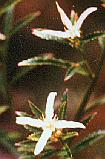|
[Front Page] [Features] [Departments] [SGAP Home Page] [Subscribe]

The Romance of Haloragodendron lucasii
Ross Doig
First recorded near "Gordon in a wild gully" in 1908, five specimens of Haloragodendron lucasii were held in the National Herbarium of New South Wales. The last specimen was collected in 1926, and following subsequent unsuccessful searches, the species was presumed extinct. That is until 1986 when Bruce Dickman, involved in a project to identify native plants, rediscovered what is thought to be the original population not far from his home at St.Ives, a northern suburb of Sydney. Following this, Parry's Nursery at Kariong propagated plants from cuttings. Since then, both the National Herbarium of NSW and the National Botanic Gardens at Canberra have been growing H.lucasii.

H.lucasii is a green, multi-stemmed shrub that grows to 1.8 metres and usually has fresh green growth on the ends of its branches. The stems are four-angled and hairless. The leaves are opposite, narrow-elliptic, 25 to 50 millimetres long and distinctly toothed on the margins. H.lucasii produces lots of white flowers in spring.
The rediscovered population was spread over a distance of at least 150 metres along a terrace below the cliff line, and appeared to comprise several hundred plants growing among and out of a tangle of Gleichenia and Bauera.
Enter Marita Sydes, a PhD student from the Australian National University who studied H.lucasii and revealed some interesting facts. She determined that the rediscovered population comprised only two plants. The first plant covered an area of 20 square metres, with its underground stems giving the appearance of many separate plants. The second plant was even larger, spreading some 120 metres along the terrace, but was discontinuous probably due to the effect of bushfires and the surrounding vegetation. It was, however, found to be a single individual or clone. More remarkable was that the plants were estimated to be 400 to 500 years old. This is a much greater age than many trees, remembering that H.lucasii is only a relatively small semi-herbaceous shrub.
A single multi-stemmed specimen found at North St Ives, and a group of plants found at North Turramurra between 1986 and 1995 also proved to be single clones.
 |
Haloragodendron lucasii is an attractive plant with fresh green foliage and small, white flowers.
Select the thumbnail image or plant name for a higher resolution image (59k).
|
But the plot thickens. Marita anticipated collecting seeds for cross-pollination studies only to find that the plants were sterile (ie. produced no pollen). It was speculated that here was a remnant plant from an earlier era bound for extinction in the short term. This startling discovery led to a concerted effort during 1995 to discover more populations of H.lucasii. Federal funds allocated for endangered flora investigation became available and Tony Auld, a senior research scientist with the NSW National Parks and Wildlife Service organised a recovery plan for this rare plant. The plan involved personnel from the NPWS, Ku-ring-gai Council, the National Herbarium of NSW, North Shore SGAP, northside bush regeneration groups, and the Australian National Botanic Gardens.
Optimism did not appear to be particularly high but in late 1995 a further population was discovered in the southern part of Ku-ring-gai Chase. It was slightly smaller in extent than the Gordon population, but unfortunately was also found to be male-sterile. Like the Gordon plants, this new discovery proved again to be one plant with many stems.
 |
The individual flowers of Haloragodendron lucasii are small but well displayed towards the ends of the branches.
Select the thumbnail image or plant name for a higher resolution image (34k).
|
Without reproduction by seed there is little chance of the species surviving in the long term. Frequent fires or a slight rise in temperature over the next few decades may be enough to make the plant disappear forever.
From my close involvement with the project, I would expect that there will be at least two more populations found and that they will be infertile. The most astonishing aspect of the whole story is the close proximity of the known populations to suburbia, together with the fact that they have been unknown until the 1995 project.
Reprinted from the February 1996 issue of "Blandfordia", the newsletter of the North Shore Group of SGAP.

[Front Page] [Features] [Departments] [SGAP Home Page] [Subscribe]
Australian Plants online - September 1998
The Society for Growing Australian Plants
|